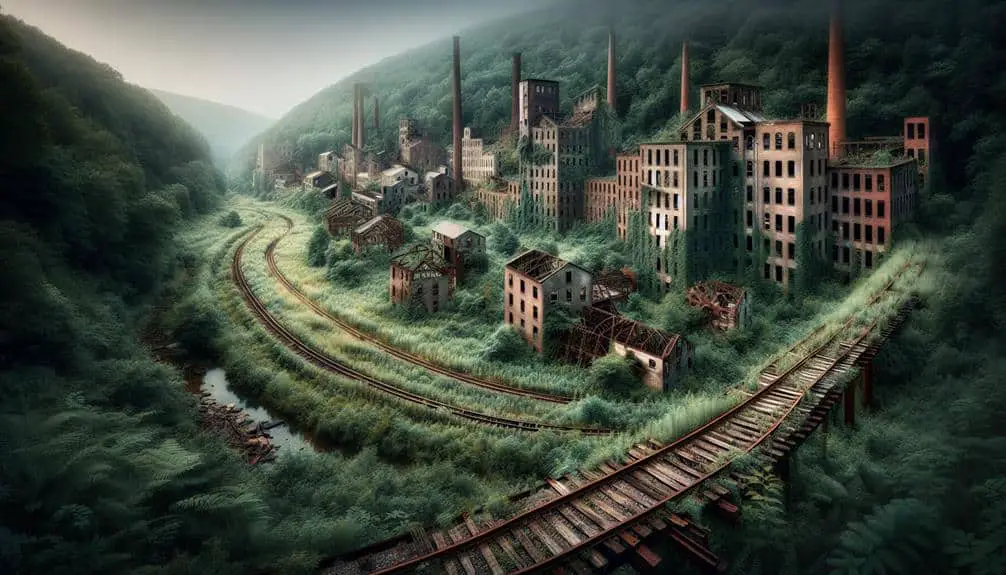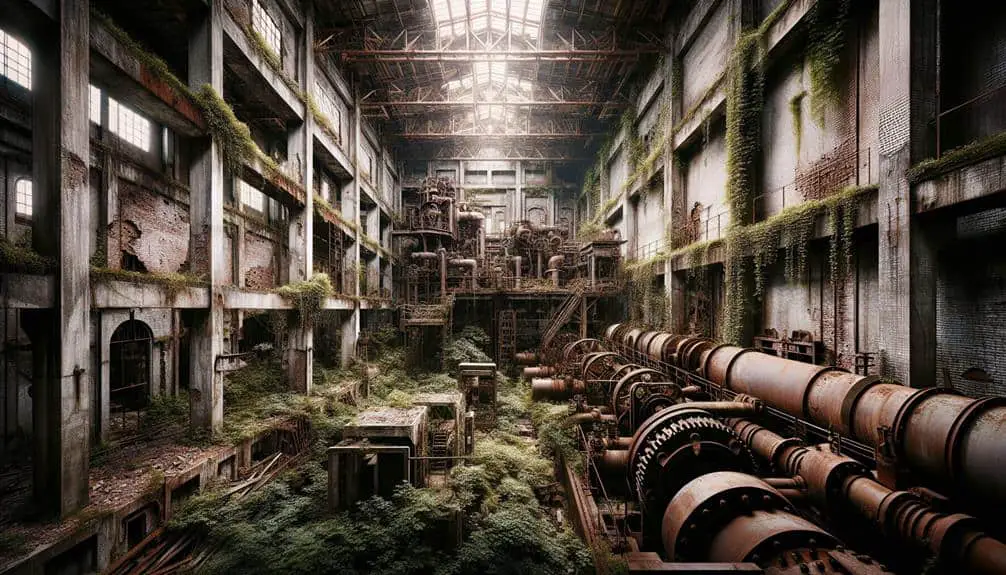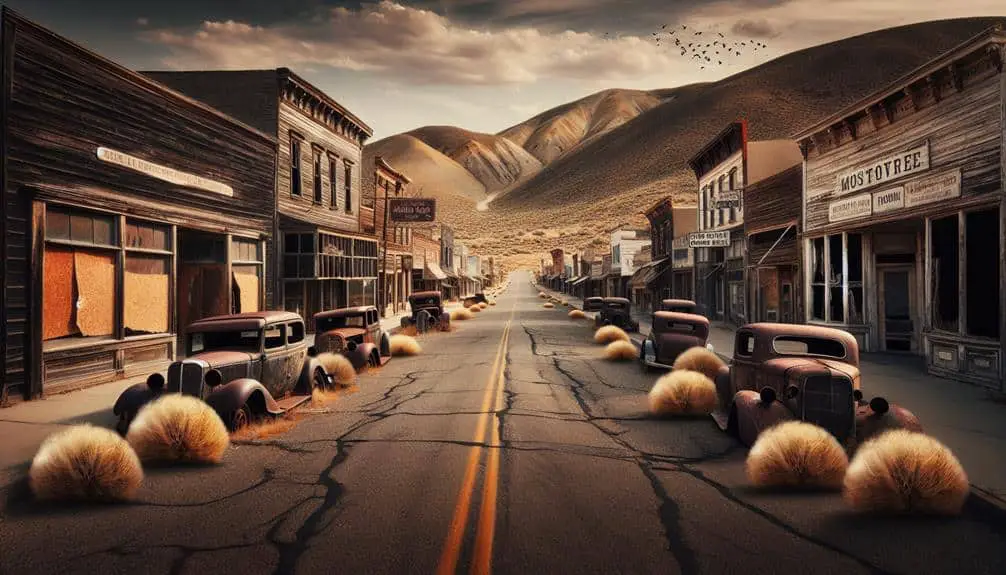If you're interested in exploring abandoned mill towns in the US, get ready to encounter a mesmerizing blend of history and mystery. Marvel at the intricate architecture and decaying machinery that recount tales of bygone industrial glory. Hear whispers of the past from ghostly encounters and unexplained phenomena that linger in these forgotten places. Discover how preservation efforts are safeguarding these haunting reminders of America's industrial past. Visit iconic mill towns like Lowell, Massachusetts, to witness the resilience of communities amidst urban decay. The charm of these abandoned towns promises to reveal a fascinating journey through time.
Key Points
- Visit Lowell, MA, for Industrial Revolution history.
- Explore Easton, PA, known for Dixie Cup factory.
- Discover Pawtucket, RI, birthplace of American Industry.
- Witness decay and resilience in abandoned mill towns.
- Connect with industrial past and community heritage.
Historical Background of Mill Towns
Explore the historical origins of mill towns in the US, revealing the intricate tapestry of industrialization's impact on local communities. During the Industrial Revolution, which took place in the 18th and 19th centuries, the landscape of America changed drastically. The establishment of mills brought forth a wave of economic growth, transforming rural areas into bustling towns centered around manufacturing hubs. These mill towns became essential cogs in the industrial machine, driving the nation's economic engine forward.
The economic impact of these mill towns was profound. They provided employment opportunities for numerous individuals, attracting workers from far and wide in search of steady jobs and a better life. The mills not only shaped the economic landscape but also influenced the social fabric of these communities. Workers lived in close-knit neighborhoods, often built and owned by the mill owners, creating a unique bond among residents.
Understanding the historical context of mill towns sheds light on the roots of industrialization and its lasting effects on local economies and societies. The legacy of these towns continues to shape the present-day landscape, serving as a reminder of the transformative power of the Industrial Revolution.
Key Features of Abandoned Mills
Abandoned mills across the US stand as silent witnesses to a bygone era, their weathered structures telling tales of a once-thriving industrial past. When exploring these abandoned mills, you'll notice several key features that highlight their architectural significance and economic impact:
- Impressive Architecture: Many abandoned mills boast stunning architectural details, such as intricate facades, towering smokestacks, and large windows that once flooded the workspaces with natural light.
- Decaying Machinery: Inside these mills, rusted and broken machinery serves as a reminder of the once-bustling production lines that have long fallen silent.
- Overgrown Surroundings: Nature has begun to reclaim these industrial sites, with vines creeping up walls and trees growing through the floors, blending the man-made structures with the surrounding landscape.
- Community Remnants: In some abandoned mills, you may stumble upon traces of the community that once thrived around them, such as abandoned houses, schools, and stores, painting a poignant picture of the economic impact these mills had on the local area.
Haunting Stories of Mill Workers
Amidst the echoing silence of abandoned mills, the haunting stories of mill workers come to life, revealing the hardships and sacrifices woven into the fabric of industrial history. Many who toiled in these mills faced grueling working conditions, long hours, and meager pay, leaving behind a legacy of perseverance and resilience.
As you explore these deserted spaces, you may encounter ghostly apparitions or hear whispers carried by the wind, tales of supernatural encounters that linger in the air.
In these desolate surroundings, the spirits of the past seem to linger, their presence felt in the creaking of rusted machinery and the shadows that dance along the walls. Some visitors report seeing figures in old-fashioned attire moving through the corridors, while others speak of unexplained cold spots and flickering lights that defy logical explanation.
These haunting stories serve as a poignant reminder of the human cost of industrialization and the importance of honoring the memory of those who labored in these mills. Each spectral encounter offers a glimpse into the lives of mill workers, preserving their stories for generations to come.
Preservation Efforts in Ghost Towns
In efforts to preserve the rich history and cultural heritage of ghost towns, dedicated individuals and organizations are actively working towards restoration and conservation projects. Engaging in community initiatives and architectural restoration efforts play a crucial role in safeguarding these historical sites for future generations.
Here are some key aspects to ponder:
- Local Partnerships: Collaborating with residents and local businesses fosters a sense of community ownership and guarantees sustainable preservation practices.
- Historical Documentation: Conducting thorough research and documentation helps in understanding the significance of each building and structure within the ghost town.
- Architectural Evaluation: Evaluating the structural integrity of buildings guides restoration efforts, ensuring authenticity while maintaining safety standards.
- Educational Programs: Implementing educational programs and guided tours raises awareness about the history and importance of these ghost towns, garnering support for preservation initiatives.
Must-Visit Mill Towns in the US
Venture into the historical heart of the United States to explore alluring mill towns that offer a glimpse into the country's industrial past. These hidden treasures hold stories of hard work, innovation, and community spirit amidst the backdrop of urban decay. One must-visit mill town is Lowell, Massachusetts, known as the cradle of the American Industrial Revolution. Walk along its cobblestone streets and marvel at the preserved mill buildings that once buzzed with textile production.
Heading south, you'll encounter Easton, Pennsylvania, where the iconic Dixie Cup factory stands as a reminder of a bygone era. The town's industrial heritage is evident in its architecture and artifacts, showcasing a blend of history and progress. Another gem is Pawtucket, Rhode Island, home to Slater Mill, the birthplace of the American Industrial Revolution. Explore the mill complex and witness the ingenuity that shaped a nation.
These must-visit mill towns beckon explorers seeking a deeper connection to America's past, offering a firsthand look at the legacy of industrialization and the resilience of communities in the face of change.
Frequently Asked Questions
Are There Any Specific Ghost Sightings or Paranormal Activities Reported in These Abandoned Mill Towns?
You might wonder if abandoned mill towns hold ghostly encounters or supernatural sightings. Reports suggest eerie happenings, shadowy figures, and unexplained sounds. These mysterious occurrences add to the allure of exploring these forgotten places.
What Impact Did the Decline of the Textile Industry Have on the Local Communities Surrounding These Mill Towns?
The decline of the textile industry had a profound impact on local communities. Economic devastation led to social unrest and migration. Environmental consequences included pollution. Despite the hardships, these towns hold historical significance, revealing the legacy of industrialization.
How Do Local Residents Feel About the Preservation Efforts Being Made in These Ghost Towns?
As a local resident, you appreciate the preservation efforts in these ghost towns. The initiatives honor the past and offer a glimpse into history. It's heartwarming to see these places cherished and kept alive.
Can Visitors Explore the Abandoned Mills on Their Own, or Are There Guided Tours Available?
You can freely explore the abandoned mills on your own through self-guided exploration. If you prefer a more structured experience, guided tours are available. Both options provide insight into the historical significance of these sites and urban exploration opportunities.
Are There Any Unique Events or Festivals Held in These Abandoned Mill Towns to Honor Their History?
You can immerse yourself in history at these abandoned mill towns through historic reenactments and cultural festivals. Witness art installations and community projects that honor the past, bringing a sense of life back to these once-thriving communities.



